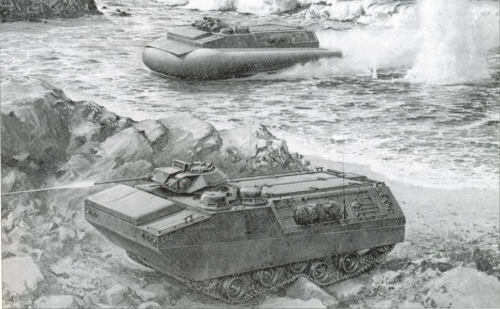rickshaw said:
Why? The EFV is a highly specialised vehicle. Throwing aside the military utility of such a vehicle for the moment, there is no reason the roles of a resupply vehicle or a mortar carrier cannot be fulfilled by cheaper, ordinary AFVs. They simply do not need the high speed of the EFV, as they would not be part of the first wave.
I don’t see how a single wave of EFVs in the numbers we’ll realistically use in an invasion can ever hope to secure a beachhead sufficiently broad to protect the arrival of follow on forces. If you want to launch the ordinary amphibious AFV from a hovercraft then well, hovercraft replacement is all the more important and its not being funded well at the moment. If you want to simply close the distance to shore and dump them into the water from an LPD-17 5-6 miles off the beach then you’ve got to assume a very secure beach for the next 30 years. Of course air assaults will help expand the lodgement but that's its own huge bag of risks against a real enemy too. Against weak enemies we can get away fine with nothing but air assault, and some amphibious combat robots to scout for mines before our hovercraft land unopposed. Personally I think this is the way things are moving anyway, no matter what happens with the EFV program.
You need resupply for EFV because it’s the only way to move engineering material such as the MCLC in view of the tiny stock EFV hatch, and it’s the only way to refuel the things quickly. EFV burns most of its fuel making that 25nm swim so this is fairly important, and its ability to stay fueled on land is restricted since certain fuel tanks are unarmored. I dunno if Marine doctrine will call for using those unarmored tanks or not on land or not.
. I do believe the current Marine plan calls for air lift of fuel, a concept I find rather questionable in scenarios in which the EFV is necessary in the first place (people with guns bigger then PKMs to shoot back with). A 120mm mortar firing guided shells is a way to get a much broader influence when it’s linked with numerous small UAVs flow off the amphibious ships as spotters. Unlike larger Cobra-F-35 CAS aircraft small spotting drones can be stored broken down below decks, so they don't compete heavily with transport choppers for space on the amphibious ships.
So basically the 120mm mortar on the beach would make up for the huge naval gunfire deficit and the ever greater work everyone seems to expect out of F-35B. The Cobra isn’t even viable as air support from a sea base 200nm offshore, and who knows when that thing will ever be replaced.
If anything, they should be looking more at a direct fire weapon system, rather than an indirect one like a mortar, to engage targets on the beach or just behind it directly. Air support, most particularly the Marines' own integral CAS such as rotary and fixed-wing would be more than sufficient for the intitial stages of the assault, particularly if supplemented by the use of a direct fire weapon such as an 90-105mm low recoil gun in a turret on the EFV hull.
Then just use a 120mm gun-mortar turret as the Euros and Russians already have several examples of this dating back to the 1970s. This way you still retain the ability to fire 120mm guided shells which is a very powerful capability, as well as being able to demolish buildings and fairly modern tanks with direct fire. In fact the Marines own LAV has been tested with more then once with turrets like this, but the Marines like the ability to dismount the mortar. My solution would be carry a second mortar tube and a baseplate externally strapped to each side. The whole LAV-25 series is overdue for replacement already, so I'd pursue new and revised EFV variants in conjunction with a new LAV series. If EFV is more capable then the LAV series can be less capable and smaller, perhaps enough to make it capable of a realistic air assault landing.


